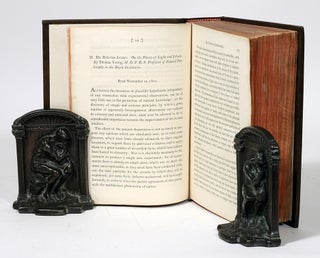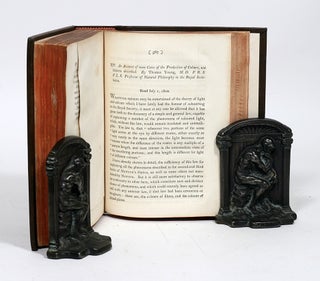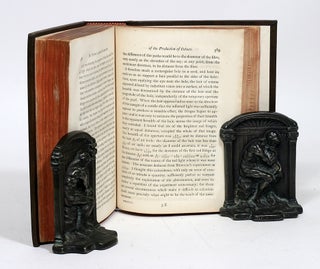The Bakerian Lecture: On the theory of light and colours. WITH: An account of some cases of the production of colours, not hitherto described
FIRST PRINTINGS of two of the most fundamental papers in modern physics: Thomas Young's evidence of the wave theory of light and the first statement of his interference principle and double-slit experiment, the most influential experiment in quantum theory.
"The Bakerian Lecture ["On the theory of light and colours"] delivered in November 1801 is an epoch-making contribution to the theory of light in all its phases. Hooke, Huygens and above all Newton had discussed the nature of light in the seventeenth century. Huygens propounded the wave theory in 1690, whereas Newton was predominantly in favour of a corpuscular theory... Though criticized by Euler and some others, the corpuscular theory held the field almost throughout the eighteenth century; but Young... based himself firmly on the theory that 'radiant light consists of undulations of the luminous ether': a theory that held the field until the latter-day notions of Planck and J.J. Thomson" (Printing and the Mind of Man, 259).
Young opens "An account of some cases of the production of colours" with the clear statement of what would come to be known as Young's interference principle, giving definitive evidence for the wave theory of light. He then describes an experiment he performed that has since become canonical in the study of modern physics:
"I therefore made a rectangular hole in a card, and bent its ends so as to support a hair parallel to the sides of the hole; then, upon applying the eye near the hole, the hair, of course, appeared dilated by indistinct vision into a surface, of which the breadth was determined by the distance of the hair and the magnitude of the hole, independently of the temporary aperture of the pupil. When the hair approached so near to the direction of the margin of a candle that the inflected light was sufficiently copious to produce a sensible effect, the fringes began to appear; and it was easy to estimate the proportion of their breadth to the apparent breadth of the hair across the image of which they extended. I found that six of the brightest red fringes, nearly at equal distance, occupied the whole of that image. The breadth of the aperture was 66/1000 [of an inch], and its distance from the hair 8/10 of an inch; the diameter of the hair was ... 1/600 [of an inch]. Hence, we have 11/1000 for the deviation of the first red fringe at the distance of 8/10; and as 8/10 / 11/1000 = 1/600 / 11/480000, or 1/43636 [of an inch] for the difference of the routes of the red light where it was most intense."
The experiment was later modified and expanded by Young to allow light to pass through two pinholes onto a screen and became known as the famous "double-slit" experiment, often called the most beautiful experiment in physics. The results of the experiment- namely that the light produced wave-like interference patters that were, later shown, to be dependent on the light's "knowledge" of which slits were open- were profound. Richard Feynman was often quoted as saying that all the issues of quantum mechanics can be understood by carefully thinking through the implications of Young's experiment.
In: Philosophical Transactions of the Royal Society, pts 1 & 2, pp 12-48; WITH: "An account of some cases of the production of colours, not hitherto described", in Philosophical Transactions, pp. 387-97. London: G. and G. Nicol, 1802. Quarto, modern calf in period style. Occasional light browning, paper flaw to corner of one leaf of first Young paper (not affecting text).
Check Availability:
P: 212.326.8907
E: michael@manhattanrarebooks.com




